

Tony Bates. Blended Learning Visually Explained for Teachers. July 10, 2016 Here is a short visual we created for teachers explaining the core notions behind the concept of Blended Learning.
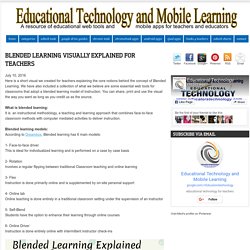
We have also included a collection of what we believe are some essential web tools for classrooms that adopt a blended learning model of instruction. You can share, print and use the visual the way you want as long as you credit us as the source. 9 case studies reveal secrets of successful blended, online learning programs. Evergreen Education Group details academic outcomes of nine different programs using Fuel Education Successful online and blended learning programs in a recent survey are those that prioritized better teacher-student relationships, used an online curriculum as a primary instructional source, and used a combination of in-person and virtual instructional support.

Over the past year, digital learning policy research and advisory firm Evergreen Education Group conducted in-depth analyses of nine schools that use online curriculum and platforms from Fuel Education (FuelEd) as the instructional foundation of their programs. After observing and interviewing groups of students, faculty, staff, and school leadership at each of the nine schools, Evergreen Education Group identified certain key characteristics that make blended and online learning programs successful, including student relationships, online curriculum as the primary source of instruction, and a variety of instructional support. Empowering Educators Means Decoding Adaptive Learning. When we published “Disrupting Class” in 2008, we didn’t use the phrase “adaptive learning” once in the book.
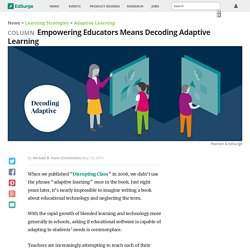
Just eight years later, it’s nearly impossible to imagine writing a book about educational technology and neglecting the term. Report: Blended Learning May Re-Engage Dropouts. (Photo: Pixabay, Creative Commons) In an effort to put a stop to the high number of students leaving high school before they graduate, a new report looks into the use of blended learning as a way to engage these students and better meet their needs as a pathway to higher education and the workforce.
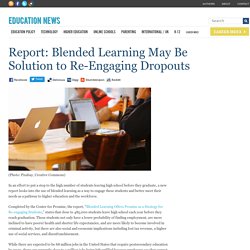
Completed by the Center for Promise, the report, “Blended Learning Offers Promise as a Strategy for Re-engaging Students,” states that close to 485,000 students leave high school each year before they reach graduation. Those students not only have a lower probability of finding employment, are more inclined to have poorer health and shorter life expectancies, and are more likely to become involved in criminal activity, but there are also social and economic implications including lost tax revenue, a higher use of social services, and disenfranchisement.
The report shows a number of reasons why students are likely to leave school before graduation. Taking the correct temperature of blended learning. The National Education Policy Center (NEPC) released a report last week warning that online and blended learning schools are struggling.
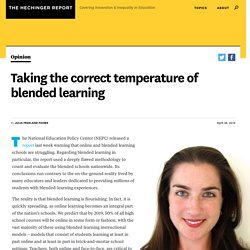
Regarding blended learning in particular, the report used a deeply flawed methodology to count and evaluate the blended schools nationwide. Its conclusions run contrary to the on-the-ground reality lived by many educators and leaders dedicated to providing millions of students with blended-learning experiences. The reality is that blended learning is flourishing. In fact, it is quickly spreading, as online learning becomes an integral part of the nation’s schools. How student empowerment drives blended learning and other tips from experts in the field. Blended learning can lead to student agency — the enabling of informed, empowered learning — when it gives students choices about what, where, when, and how they learn.
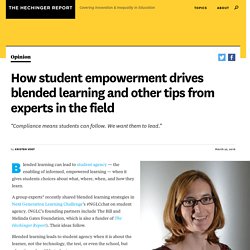
A group experts* recently shared blended learning strategies in Next Generation Learning Challenge’s #NGLCchat on student agency. (NGLC’s founding partners include The Bill and Melinda Gates Foundation, which is also a funder of The Hechinger Report). Their ideas follow. Blended learning leads to student agency when it is about the learner, not the technology, the test, or even the school, but when it reaches ALL students. Education consultant Chris Watkins has identified performance-focused practices he calls “space invaders” because they take up space in the classroom that should be devoted to learning practices. Using Quizlet's New "Live" Feature - Teaching with Technology.
Do you ever stumble upon an app or a website and think, “nah I don’t need to look at this,” or “this is cool, but I’ll check it out later,” … and then you never look at it again?

This was my relationship with Quizlet until last week. I read about an addition Quizlet made to their website, probably on Twitter or Pinterest, and decided to give it a go to see what it was all about. Wow! Quizlet, I’m sorry I avoided you for so long! Blended Learning Helps Students at Different Cognitive Levels. What is the best way to meet today’s students “in the middle?”
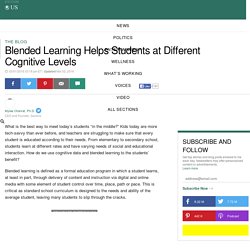
Kids today are more tech-savvy than ever before, and teachers are struggling to make sure that every student is educated according to their needs. From elementary to secondary school, students learn at different rates and have varying needs of social and educational interaction. 6 Ways Teachers Are Using Blended Learning. 6 Blended Learning Models & Platforms by Christi Wilson Imagine a classroom where the students have the ability to spend their class time collaborating with other students, receiving additional support from the teacher, or working on hands on projects with their peers.

Forbes Welcome. 37 Blended Learning Resources You Can Use Tomorrow. 37 Blended Learning Resources You Can Use Tomorrow by Dr.
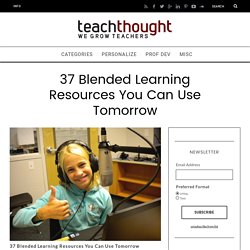
Justin Marquis Remixing the curriculum – compiling resources from a variety of sources such as free online texts, proprietary information from publishers, and self-created media such as podcasts – is starting to push its way into K-12 and higher education. Get ahead of the curve with these tips for remixing your own online course materials. Gathering the Ingredients Before Remixing Like any course development process, there is a good deal of research that goes into remixing the contents of a new or existing class curriculum. Consider including a small selection of remixed materials at first and expand each time you teach the class. Proposing A Blended Learning Approach For K12 Education. ABC school system (a pseudonym for a school district) prides itself on providing quality education that supports its students, parents, and community members.
This school system is comprised of 38 schools with an average daily attendance of approximately 30,000 students. The school’s mission statement is “To Educate and Empower Our Students to Reach Their Potential”. Additionally, the school system’s goal is to increase student achievement by maximizing efficiency and effectiveness while using its resources to support school needs. Reflections on the Blended Learning Roadmap. Innovative learning leaders shared their experiences in implementing blended learning in their schools and districts during a recent iNACOL webinar, “Blended Learning Leaders Discuss their Roadmap for Success.”
As a preview to a forthcoming publication: the iNACOL Blended Learning Roadmap, the leaders provided a glimpse into promising practices that have resulted in some early successes, as well as some of the potential challenges that others may face when initiating a blended program. The speakers, whose schools are profiled in the Blended Learning Roadmap, shared first-hand experiences and how their schools/district addressed each of the six elements of the Roadmap. Let’s Play Blended Learning Buzzword Bingo! An Interview With Michael Horn. Michael Horn has been a powerful force shaping the changes in education over the past decade. His new book, Blended, elaborates on the different approaches that schools can take to create a better learning experience, and how technology can support those goals. Horn sat down with senior editor Mary Jo Madda at our California Summit. Why competency-based learning isn't happening anytime soon.
By Michael B. Horn November 9th, 2015 Regulatory noise stifles, slows rise of competency-based learning. Earlier this month, Inside Higher Ed reported on how the Department of Education’s Office of Inspector General is stymying the rise of competency-based learning in higher education—and is at odds with the rest of the Department, which has been enthusiastic about competency-based learning’s potential. The inspector general released a critical audit of how the Higher Learning Commission, a regional accreditor, considered colleges’ proposals for new competency-based credentials, in particular around whether the programs being approved had “regular and substantive” interaction between faculty members and students in academic programs.
I, along with many others, have pointed out numerous times that this particular regulation makes little sense in today’s world of emerging online, competency-based programs—and we should instead be moving toward outcomes-based judgments around institutions. 10 Habits That Separate Top-Notch eLearning Professionals From The Rest. Have you ever met a top-notch eLearning professional? Have you ever wondered what makes them exceptional? In this article, I’ll share 10 habits that separate truly great eLearning professionals from the mediocre ones in order for you to understand what it takes to stand out from the crowd in the eLearning industry. What separates the best from the rest? I’m sure that the first word that comes to mind is “talent”. Granted, talent is important; but it is not enough on its own. This is what Top-Notch eLearning Professionals do to stand out from the crowd: They don’t give up.Thomas Edison had famously said “I have not failed; I’ve just found 10.000 ways that won’t work”.
13 Keys to Successful Blended Learning. 13 Keys to Successful Blended Learning. The Best Advice for Creating Student-Centered Learning. How do you own your own learning? What motivates you to take it upon yourself to seek out new knowledge and skills? Is someone holding your feet to the fire? What makes you want to practice your musical instrument or your favorite sport?
When you can answer these questions, you can then apply them to your students. We teachers are always looking for ways to tap into our student’s impulse to learn what interests them on their own. The Newbies Blueprint On How To Create A Blog. Blending technology and traditional teaching shows promise. A long time ago, in a classroom not so far away, a teacher stood at the chalkboard and taught. Fast forward to a school today, and you might find kids tapping away on laptops, recording oral histories on tablets or learning math problems via YouTube. 6 Models of Blended Learning Teachers Should Know About. New York City schools ask students to ‘Bring Your Own Devices’ NEW YORK — Amy Thiam, a fourth-grader at Harlem’s P.S. 129, is staring at her cellphone in class — just as her teacher instructed. EdCafe in the Classroom. An EdCafe is a way to structure class that promotes student choice and ownership over learning.
The model was inspired by EdCamp conferences, where participants build the schedule and choose what sessions to attend. This bottom-up approach shifts energy, engagement, and opportunity for exploration to the students, and transforms the teacher into expert facilitator instead of gatekeeper/manager. What’s next: Blended Learning 2.0. PROVIDENCE, R.I. — Rhode Island is fertile ground for experimentation with technology in classrooms as it seeks to the first fully blended learning state in the nation.
We cannot rely on the internet to teach our children. Online learning is having a substantial impact on classrooms across the country and around the world. The recent announcement of the College Board’s partnership with Khan Academy to make online SAT test preparation available for free is a good example. Now, all students—regardless of socio-economic status—will have access to high-quality tools that will help them prepare for the redesigned SAT. Blended learning: The great new thing or the great new hype? This is the learning lab at Rocketship Discovery Prep in San Jose, Calif., Monday April 30, 2012.
Blended learning emerges as a leading trend in education technology, report says. PHILADELPHIA — The use of blended learning in schools has increased the adoption of educational technology as the public has grown fond of online learning, according to a new report. What is Blended Learning? Teacher Guides for Technology And Learning. What makes a good online learning experience? The Flipped Classroom FAQ. Online & Blended Learning: Hanging up Your. Blending Analog and Digital in Student Projects. Moving Beyond the 'Does Blended Learning Work?' Question. Student Engagement with Blended Learning: 9 Unique Ideas. How Blended Learning Changed My Classroom Experience: A Student Perspective.
Moving Beyond the 'Does Blended Learning Work?' Question. 6 Models of Blended Learning Teachers Should Know About. PBL Resources. Education Week. Blended Learning Visually Explained for Teachers. Tips to Engage 21st Century Students. Donald Clark Plan B: 7 tests that expose Blended Learning as actually Blended ‘Teaching’ Students as Contributors: Digital Learning Farm. Building Your EdTech Ecosystem. Making The Shift To Mobile-First Teaching. Education Week. PATINS PROJECT -Rapid Fire- - Goodbye, PowerPoint! Go Where You Grow. Not Yet Blended Learning. Project-based learning affords multiple representations of knowledge. Why Some Teachers Are Against Technology In Education. The best Google Drive cheat sheets.
Classroom Google In A Primary Classroom...Oh Yes!!!! Not Yet Blended Learning. It’s called blended learning (not blended teaching) for a reason. The elements of #blendedlearning implementation. The Backchannel: Giving Every Student a Voice in the Blended Mobile Classroom. 4 Tips for Getting to Know the Blended Instructional Model. The elements of #blendedlearning implementation.